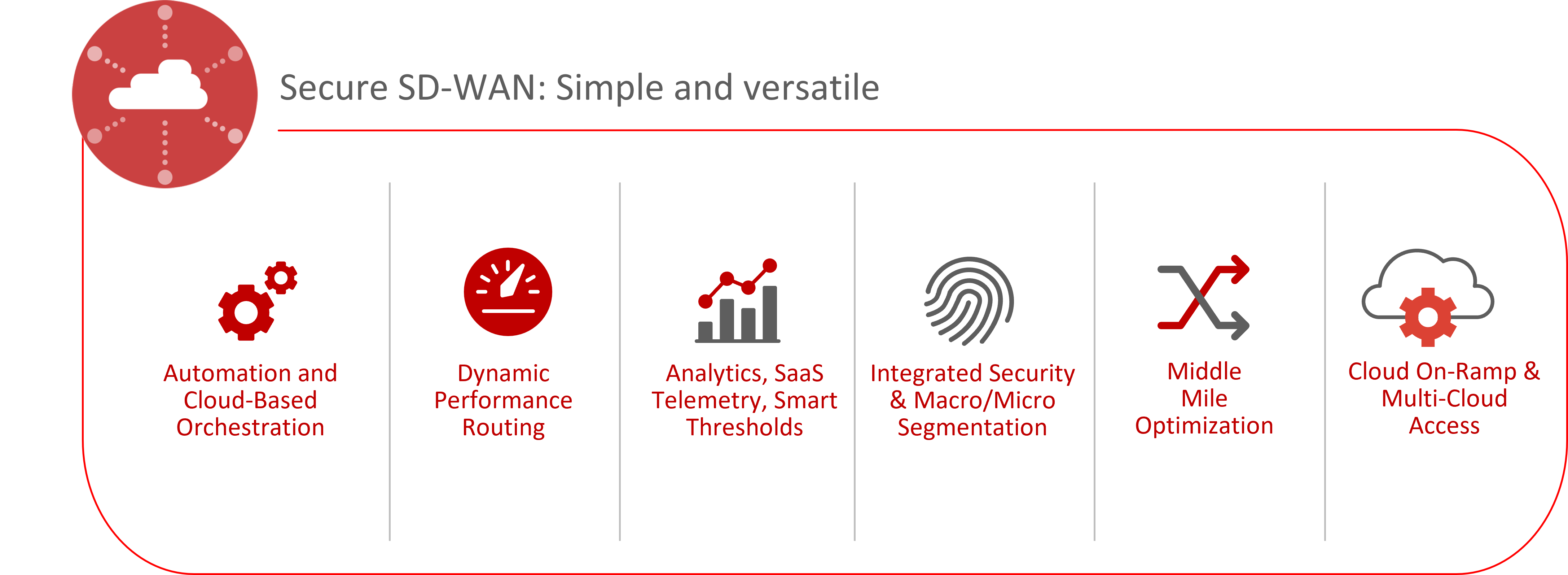Benefits of Cisco SD-WAN
Cisco SD-WAN, specifically, offers a range of benefits tailored to address the challenges of modern networking. Some key advantages of Cisco SD-WAN include:
1. Application Optimisation:
Cisco SD-WAN optimises application performance by dynamically selecting the best path for traffic based on real-time network conditions. This ensures that critical applications receive priority, leading to improved user experience.
2. Cost Efficiency:
Cisco SD-WAN allows organisations to leverage cost-effective internet connections while maintaining the reliability and performance traditionally associated with MPLS networks. This results in significant cost savings in terms of network connectivity.
3. Centralised Management with vManage:
The vManage orchestrator provides a centralised management interface, enabling administrators to easily configure, monitor, and troubleshoot the entire Cisco SD-WAN deployment. This centralised control enhances visibility and simplifies network operations.
4. Security Integration:
Cisco SD-WAN incorporates robust security features, including integrated firewalls, encryption, and threat intelligence integration. This ensures a secure network environment and protects data in transit across the WAN.
5. Application-Aware Routing with Intelligent Path Selection:
Cisco SD-WAN intelligently routes traffic based on application requirements, providing optimal performance. The solution dynamically selects the most efficient path, improving bandwidth utilisation and reducing latency.
6. Cloud Connectivity:
Cisco SD-WAN facilitates seamless and secure connectivity to various cloud environments, supporting organisations in their cloud adoption strategies. This includes direct connections to major cloud providers such as Microsoft Azure.
7. Zero-Touch Provisioning:
Cisco SD-WAN simplifies deployment with zero-touch provisioning, allowing remote offices to be quickly and easily integrated into the network. This feature accelerates the deployment process and reduces the need for on-site IT support.
8. Scalability:
Cisco SD-WAN is designed to scale with the evolving needs of businesses. It supports the rapid and seamless integration of new locations into the network, providing flexibility for organisational growth.
9. Visibility and Analytics:
Cisco SD-WAN offers advanced analytics and reporting tools, providing detailed insights into network performance and application behaviour. This visibility enables proactive monitoring and efficient troubleshooting.
10. Integration with Cisco Security Solutions:
Cisco SD-WAN can be seamlessly integrated with other Cisco security solutions, creating a comprehensive security infrastructure. This integration enhances the overall security posture and ensures consistent policy enforcement.
Case Studies
One of our customers Al Ghandi Auto is a prominent automotive retailer in the UAE. They wanted to improve their network performance and take advantage of the benefits of the Cloud with minimal costs.
Businesses in the UAE face limitations in network choices based on their physical location, often requiring multiple offices or branches to manage two separate MPLS networks. This traditional approach is burdensome, expensive to install and maintain, and lacks visibility into network applications. The prospect of connecting two circuits and establishing an MPLS connection to Azure was cost-prohibitive, posing a threat to Al Ghandi Group's cloud migration project. In light of SAP's move away from supporting on-premise ERP systems by 2027, Al Ghandi Auto Group aimed to future-proof their business by seeking more flexible network options.
Orixcom proposed a comprehensive solution for Al Ghandi Group by implementing Managed SD-WAN and CloudConnect services to enhance their network infrastructure and secure connectivity to Azure. With the deployment of Managed SD-WAN, Al Ghandi Group transitioned away from the traditional MPLS network, gaining significantly improved flexibility, heightened network visibility, and enhanced control.
Another customer, CNBC Arabia is a 24-hour financial and business information channel headquartered in Media City, Dubai. They have bureaus in Qatar, KSA, Cairo, Kuwait and London and also have correspondents based in Iraq and Jordan.
CNBC faced challenges using IPSec (VPN) for media file transfers between locations, as their existing firewall hardware implementation caused frequent connection failures, resulting in significant broadcast preparation delays. Transferring media files across bureaus and the head office became a formidable obstacle, affecting journalists' ability to submit stories and upload essential content promptly.
In response, Orixcom proposed an SD-WAN solution connecting offices and bureaus throughout the Middle East region. The implemented SD-WAN ensured successful first-time, every-time file transfers from any network location, eliminating delays in delivering content, thereby increasing overall productivity and ensuring timely broadcasting. Additionally, the SD-WAN solution provided the flexibility to seamlessly incorporate new locations, addressing CNBC's connectivity challenges efficiently.
Emerging Technologies Shaping the Future of SD-WAN:
1. Edge Computing Integration:
SD-WAN is likely to integrate more closely with edge computing to support the increasing demand for low-latency applications. This integration can enhance the performance of applications by processing data closer to the source.
2. AI and Machine Learning:
The incorporation of artificial intelligence (AI) and machine learning (ML) into SD-WAN solutions can optimise network performance, automate troubleshooting, and enhance security by identifying and responding to anomalies in real-time.
3. Zero Trust Security Models:
As security remains a top concern, SD-WAN is expected to adopt and strengthen zero-trust security models, ensuring that every device and user is verified before granting access to the network.
4. 5G Integration:
With the deployment of 5G networks, SD-WAN solutions may leverage the increased bandwidth and low latency to provide faster and more reliable connectivity, especially for mobile and IoT devices.
5. Multi-Cloud Connectivity:
The future of SD-WAN is likely to focus on providing seamless connectivity and management across multiple cloud environments. This ensures optimal performance for applications hosted in various cloud platforms.
6. Application Performance Optimisation:
SD-WAN solutions will continue to evolve in terms of application-aware routing and optimisation, ensuring that critical applications receive the necessary bandwidth and low latency for enhanced user experience.
Cisco's Roadmap for SD-WAN Development:
Cisco has been a key player in the SD-WAN space, and its roadmap for development is expected to align with industry trends. Some potential areas of focus include:
- Enhanced Security Integrations:
Cisco is likely to continue strengthening the security features of its SD-WAN solutions, integrating advanced threat detection, encryption, and secure access controls. - Cloud-Native Architecture: Cisco will look to emphasise a more cloud-native architecture to support the growing trend of applications being hosted in various cloud environments. This could involve closer integration with cloud service providers.
- Automation and Orchestration: Cisco is likely to enhance automation and orchestration capabilities, simplifying the deployment, management, and maintenance of SD-WAN solutions for enterprises.
- Integration with Cisco's Networking Portfolio: Integration with other networking solutions within Cisco's portfolio, such as Cisco DNA (Digital Network Architecture), to provide a comprehensive and unified networking infrastructure.
- User Experience Improvements: Cisco may focus on improving the overall user experience by providing intuitive management interfaces, proactive monitoring, and rapid issue resolution through AI-driven analytics.
FAQs
- How does Cisco SD-WAN improve application performance?
Cisco SD-WAN improves application performance by dynamically optimising the routing of traffic based on real-time network conditions. Through its application-aware routing capabilities, SD-WAN identifies and classifies applications, allowing it to prioritise critical applications and allocate the appropriate bandwidth. This intelligent traffic steering ensures that data takes the most efficient path across the network, reducing latency and enhancing overall performance. Additionally, Cisco SD-WAN provides visibility into application behaviour, enabling administrators to monitor and troubleshoot network issues promptly, resulting in improved user experience and increased productivity. - Can Cisco SD-WAN be seamlessly integrated into existing networks?
Yes, Cisco SD-WAN is designed to be seamlessly integrated into existing networks. Cisco provides solutions and migration strategies that allow organisations to adopt SD-WAN without disrupting their current network infrastructure. This integration is facilitated by the overlay architecture of SD-WAN, which creates a virtualised layer on top of the existing network. The SD-WAN edge devices can coexist with traditional routers, and the solution is often compatible with various transport networks, including MPLS, broadband, and LTE. This allows organisations to gradually transition to SD-WAN, maintaining connectivity during the migration process. Cisco also offers tools and services to assist in the planning and execution of the integration, ensuring a smooth and efficient transition to SD-WAN without causing significant disruptions to ongoing operations. - What are the security challenges of SD-WAN?
Implementing SD-WAN introduces security challenges, including increased internet exposure at branch offices and potential threats to data in transit, necessitating robust encryption measures. Visibility into encrypted traffic, consistent policy enforcement, and integration with existing security infrastructure become complex, and direct internet access at branch offices poses risks. Vendor-specific vulnerabilities, user authentication concerns, and compliance requirements further contribute to security challenges. Organisations must focus on network edge security, regular updates, and operational best practices to mitigate risks associated with misconfigurations and human errors. A comprehensive strategy involving encryption, access controls, threat detection, and ongoing security training is essential to address these challenges and ensure a secure SD-WAN deployment. Implementing SD-WAN as part of a SASE solution allows businesses to realise the benefits of SD-WAN as well as implementing full network edge security. SD-WAN can also be implemented with Cisco Umbrella to provide an extra layer of security.






